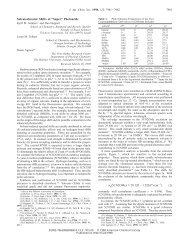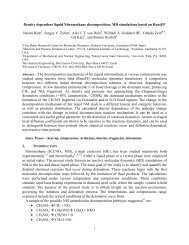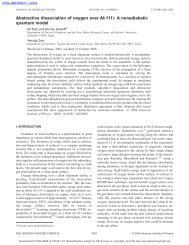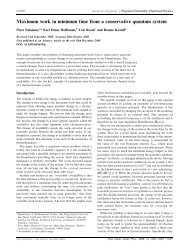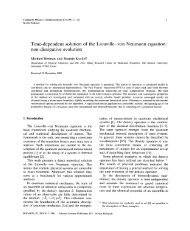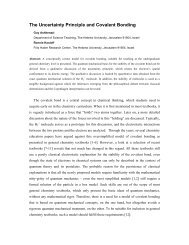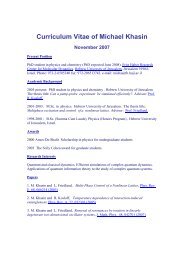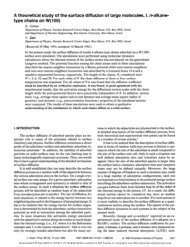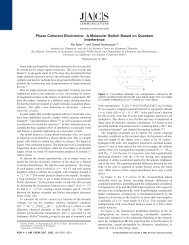Molecular Symmetry Properties of Conical Intersections and ...
Molecular Symmetry Properties of Conical Intersections and ...
Molecular Symmetry Properties of Conical Intersections and ...
Create successful ePaper yourself
Turn your PDF publications into a flip-book with our unique Google optimized e-Paper software.
2996 J. Phys. Chem. A, Vol. 114, No. 9, 2010 Al-Jabour et al.<br />
for 1 e i < j e jmax. Determination <strong>of</strong> the IREPs <strong>of</strong> the τk i,j (s)<br />
will also provide their relative signs at the symmetry-related<br />
nuclear coordinates (1).<br />
Accordingly, for the present example C5H4NH, we shall<br />
investigate the molecular symmetry properties <strong>of</strong> the radial <strong>and</strong><br />
torsional NACTs τr 0,1 , τr 0,2 , <strong>and</strong> τr 1,2 <strong>and</strong> τ 0,1 , τ 0,2 , <strong>and</strong> τ 1,2 ,<br />
respectively. The properties <strong>of</strong> the complementary NACTs τr 1,0 ,<br />
etc., follow from the antisymmetry relation 10. It will also be<br />
useful to determine the IREPs with respect to the alternative<br />
derivatives ∂/∂x <strong>and</strong> ∂/∂y; see eq 5. Relation 12 is specified as<br />
i,j i,j<br />
|τk ([{r, }])| ) |τk ([{r, -π + }])|<br />
i,j i,j<br />
) |τk ([{r, -}])| ) |τk ([{r, π - }])| (13)<br />
for i, j ) 0,1or0,2or1,2<strong>and</strong>{sk} ) {r,} or{x,y}, together<br />
with the antisymmetry relation 10.<br />
E. <strong>Molecular</strong>-<strong>Symmetry</strong>-Based Theorems for the NACTs.<br />
(v) Fifth, based on steps i-iv, we are now ready to derive two<br />
symmetry theorems which relate the IREPs <strong>of</strong> different NACTs<br />
to each other. Specifically, the first relation is for NACTs τk i,j<br />
<strong>and</strong> τl i,j with the same set <strong>of</strong> electronic states i, j but with<br />
derivatives with respect to different symmetry-adapted coordinates<br />
sk <strong>and</strong> sl, respectively. Relation 11 then implies that<br />
i,j<br />
Γ(τk ) × Γ( ∂<br />
∂sl) ) Γ(ψi (se ; s)) × Γ( ∂<br />
∂sk) × Γ(ψj (s ∂<br />
e ; s)) × Γ(<br />
i,j<br />
) Γ(τl ) × Γ( ∂<br />
∂sk) (14)<br />
or<br />
∂s l)<br />
i,j<br />
Γ(τk ) ) Γ( ∂ ∂<br />
×<br />
∂sk) Γ( ∂sl) × Γ(τ i,j<br />
l ) (15)<br />
Theorem 15 yields the irreducible representations <strong>of</strong> all <strong>of</strong> the<br />
NACTs from the irreducible representations <strong>of</strong> a single NACT,<br />
for the same electronic states i <strong>and</strong> j, simply by multiplication<br />
with the product <strong>of</strong> the IREPs <strong>of</strong> the derivatives <strong>of</strong> the<br />
corresponding two different symmetry-adapted coordinates.<br />
Application to the present example C5H4NH with molecular<br />
symmetry group C2V(M) allows one to set up four possible<br />
combinations <strong>of</strong> IREPs <strong>of</strong> the NACTs with respect to the<br />
derivatives <strong>of</strong> the coordinates r, , x, <strong>and</strong> y; these are listed in<br />
Table 1. For example, if Γ(τr i,j ) ) A1, then theorem 15 implies<br />
that Γ(τ i,j ) ) A2, Γ(τx i,j ) ) B2, <strong>and</strong> Γ(τy i,j ) ) B1. Note, however,<br />
that theorem 15 does not suffice per se to decide which <strong>of</strong> the<br />
four possible combinations apply to a given set <strong>of</strong> electronic<br />
states i <strong>and</strong> j. Table 1 already anticipates that τk 1,2 transforms<br />
according to the second combination, whereas τk 0,1 <strong>and</strong> τk 0,2<br />
transform according to the third one, but these assignments<br />
require additional steps; see below.<br />
The second symmetry theorem relates the IREPs <strong>of</strong> NACTs<br />
for the derivatives with respect to the same symmetry-adapted<br />
coordinate ∂/∂sk but for different electronic states to each other.<br />
For this purpose, let us consider a loop-type sequence <strong>of</strong> Nloop<br />
molecular states with the same spin multiplicity, e.g., singlet<br />
states Sa, Sb, Sc, ... , Sy, Sz ) Sa, i.e., starting <strong>and</strong> ending with<br />
the same state Sa ) Sz. The corresponding NACTs are τk a,b ,<br />
τk b,c , ... , τk y,z ) τk y,a . Let us now consider the product<br />
a,b,c,...,y,z)a a,b b,c y,z)a<br />
τ˜ k ) τk τk ... τk<br />
(16)<br />
The IREP <strong>of</strong> τ˜k a,b,c,...,y,z)a can then be determined from the product<br />
theorem for the IREPs <strong>of</strong> the underlying electronic wave<br />
functions ψi(se; s) <strong>and</strong> ψj(se; s) as well as the derivatives <strong>of</strong> the<br />
symmetry-adapted coordinates ∂/∂sk. Using eq 11 <strong>and</strong> focusing<br />
on 1-d IREPs, we obtain<br />
a,b,c,...,y,z)a<br />
Γ(τ˜ k ) ) Γ(ψa (se ; s)) 2 × Γ(ψb (se ; s)) 2 × ... × Γ(ψy (se ; s)) 2 × Γ( ∂<br />
∂sk) Nloop<br />
) {Γ( ∂<br />
∂sk) if Nloop is odd<br />
A1 if Nloop is even<br />
Theorem 17 imposes a condition on the IREPs <strong>of</strong> the NACTs<br />
τk i,j which contribute to the loop (16). Analogous conditions can<br />
be derived for similar loops for NACTs τk a,b τl b,c ... with respect<br />
to different symmetry-adapted coordinates sk, sl, etc., but these<br />
do not provide any additional information because they can be<br />
re-expressed in terms <strong>of</strong> theorems 15 <strong>and</strong> 17.<br />
In order to demonstrate the power <strong>of</strong> theorem 17, let us<br />
consider the example <strong>of</strong> C5H4NH <strong>and</strong> the loop <strong>of</strong> Nloop ) 3<br />
electronic states S0, S1, S2, S0, thus<br />
0,1,2,0 0,1 1,2 2,0<br />
τ˜ k ) τk τk τk<br />
(17)<br />
(18)<br />
For sk ) , theorem 17 yields the relation <strong>of</strong> the IREPs <strong>of</strong> the<br />
NACTs with respect to the ∂/∂ derivatives<br />
0,1,2,0 0,1 1,2 2,0<br />
Γ(τ˜ ) ) Γ(τ ) × Γ(τ ) × Γ(τ ) ) Γ( ∂<br />
∂) ) A2 (19)<br />
Likewise, for the NACTs with respect to the ∂/∂r derivatives,<br />
theorem 17 yields<br />
0,1,2,0 0,1 1,2 2,0<br />
Γ(τ˜ r ) ) Γ(τr ) × Γ(τr ) × Γ(τr ) ) Γ( ∂<br />
∂r) ) A1 (20)<br />
The relations 19 <strong>and</strong> 20 for the NACTs with respect to the<br />
derivatives ∂/∂ <strong>and</strong> ∂/∂r, respectively, imply symmetry constraints<br />
on their IREPs. For example, if the IREPs are known<br />
for two <strong>of</strong> the NACTs with respect to ∂/∂, say, Γ(τ 0,1 ) <strong>and</strong><br />
Γ(τ 0,2 ), then the IREP <strong>of</strong> the third one, i.e., Γ(τ 1,2 ), follows<br />
automatically from relation 19. An example is anticipated in<br />
Table 1, i.e., Γ(τ 0,1 ) ) Γ(τ 0,2 ) ) B1 implies Γ(τ 1,2 ) ) A2. Note<br />
that, on one h<strong>and</strong>, theorem 17 establishes a useful relation (or<br />
more, if additional loops <strong>of</strong> electronic states are available)<br />
between the NACTs <strong>of</strong> the loop <strong>of</strong> electronic states (16). On<br />
the other h<strong>and</strong>, it does not suffice per se to discover the IREPs<br />
<strong>of</strong> all <strong>of</strong> the NACTs; additional steps are necessary, for that<br />
purpose; see item vi. In any case, the two theorems 15 <strong>and</strong> 17<br />
are applicable without ever calculating the electronic wave<br />
functions or the NACTs explicitly.<br />
F. Signs <strong>of</strong> NACTs at <strong>Symmetry</strong>-Related Positions. (vi)<br />
Next, we note that theorem 15 allows one to determine relations<br />
between different patterns <strong>of</strong> relative signs <strong>of</strong> the NACTs at<br />
the sets <strong>of</strong> symmetry-related values <strong>of</strong> coordinates, as well as<br />
corresponding different symmetric nodes for the τk i,j (s), depending<br />
on the IREPs <strong>of</strong> the different derivatives ∂/∂sk. For this



